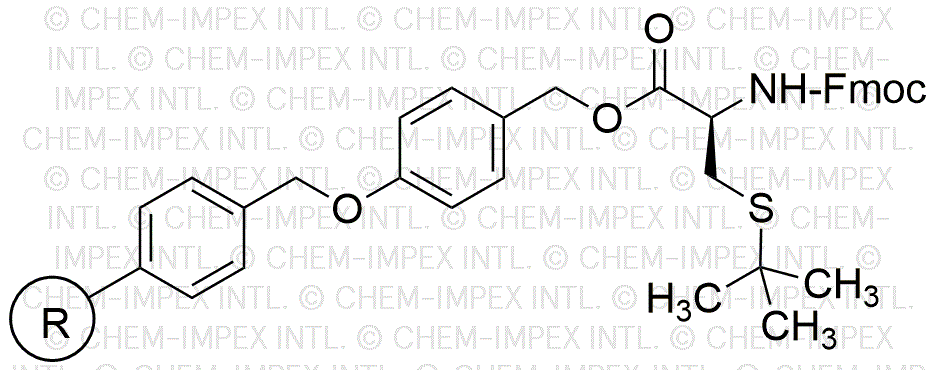Fmoc-S-tert-butyl-L-cysteine 4-alkoxybenzyl alcohol resin is widely utilized in research focused on:
- Peptide Synthesis: This resin is essential in solid-phase peptide synthesis, allowing for the efficient assembly of peptides with high purity and yield.
- Drug Development: It serves as a key intermediate in the development of peptide-based therapeutics, particularly in creating novel drugs targeting specific diseases.
- Bioconjugation: The resin facilitates the attachment of peptides to various biomolecules, enhancing the efficacy of drug delivery systems and improving targeting capabilities.
- Protein Engineering: Researchers use this compound to modify proteins, enabling the study of protein interactions and functions, which is crucial in understanding biological processes.
- Material Science: It is applied in the development of smart materials, where peptide sequences can be integrated into polymers for advanced applications in biomedical devices.
General Information
Properties
Safety and Regulations
Applications
Fmoc-S-tert-butyl-L-cysteine 4-alkoxybenzyl alcohol resin is widely utilized in research focused on:
- Peptide Synthesis: This resin is essential in solid-phase peptide synthesis, allowing for the efficient assembly of peptides with high purity and yield.
- Drug Development: It serves as a key intermediate in the development of peptide-based therapeutics, particularly in creating novel drugs targeting specific diseases.
- Bioconjugation: The resin facilitates the attachment of peptides to various biomolecules, enhancing the efficacy of drug delivery systems and improving targeting capabilities.
- Protein Engineering: Researchers use this compound to modify proteins, enabling the study of protein interactions and functions, which is crucial in understanding biological processes.
- Material Science: It is applied in the development of smart materials, where peptide sequences can be integrated into polymers for advanced applications in biomedical devices.
Documents
Safety Data Sheets (SDS)
The SDS provides comprehensive safety information on handling, storage, and disposal of the product.
Product Specification (PS)
The PS provides a comprehensive breakdown of the product’s properties, including chemical composition, physical state, purity, and storage requirements. It also details acceptable quality ranges and the product's intended applications.
Certificates of Analysis (COA)
Search for Certificates of Analysis (COA) by entering the products Lot Number. Lot and Batch Numbers can be found on a product’s label following the words ‘Lot’ or ‘Batch’.
*Catalog Number
*Lot Number
Certificates Of Origin (COO)
This COO confirms the country where the product was manufactured, and also details the materials and components used in it and whether it is derived from natural, synthetic, or other specific sources. This certificate may be required for customs, trade, and regulatory compliance.
*Catalog Number
*Lot Number
Safety Data Sheets (SDS)
The SDS provides comprehensive safety information on handling, storage, and disposal of the product.
DownloadProduct Specification (PS)
The PS provides a comprehensive breakdown of the product’s properties, including chemical composition, physical state, purity, and storage requirements. It also details acceptable quality ranges and the product's intended applications.
DownloadCertificates of Analysis (COA)
Search for Certificates of Analysis (COA) by entering the products Lot Number. Lot and Batch Numbers can be found on a product’s label following the words ‘Lot’ or ‘Batch’.
*Catalog Number
*Lot Number
Certificates Of Origin (COO)
This COO confirms the country where the product was manufactured, and also details the materials and components used in it and whether it is derived from natural, synthetic, or other specific sources. This certificate may be required for customs, trade, and regulatory compliance.

